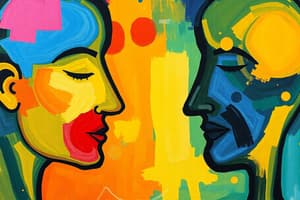Podcast
Questions and Answers
What is the goal of the RESPECTFUL model?
What is the goal of the RESPECTFUL model?
To recognize the multidimensionality of all clients in a comprehensive and integrative way.
Who developed the RESPECTFUL model and when?
Who developed the RESPECTFUL model and when?
Michael D'Andrea, Ed.D. and Judy Daniels around 1997.
What does RESPECTFUL stand for?
What does RESPECTFUL stand for?
R: Religious, E: Economic Class Background, S: Sexual Identity, P: Psychological Maturity, E: Ethnic-Cultural-Racial Identity, C: Chronological Developmental Challenges, T: Trauma and Other Threats to One's Well-Being, F: Family History and Dynamics, U: Unique Physical Characteristics, L: Location of Residence and Language Differences.
What does 'Religious' refer to in the RESPECTFUL model?
What does 'Religious' refer to in the RESPECTFUL model?
How does economic class background influence a client according to the RESPECTFUL model?
How does economic class background influence a client according to the RESPECTFUL model?
How does sexual identity affect personal development?
How does sexual identity affect personal development?
What is meant by psychological maturity in the RESPECTFUL model?
What is meant by psychological maturity in the RESPECTFUL model?
What role does ethnic-cultural-racial identity play in psychological development?
What role does ethnic-cultural-racial identity play in psychological development?
What are chronological developmental challenges?
What are chronological developmental challenges?
How do trauma and threats to well-being affect individuals?
How do trauma and threats to well-being affect individuals?
What impact does family history and dynamics have on a person?
What impact does family history and dynamics have on a person?
How do unique physical characteristics affect clients?
How do unique physical characteristics affect clients?
What does location of residence and language differences signify in the RESPECTFUL model?
What does location of residence and language differences signify in the RESPECTFUL model?
Why is the RESPECTFUL model considered valuable?
Why is the RESPECTFUL model considered valuable?
Flashcards are hidden until you start studying
Study Notes
RESPECTFUL Model Overview
- The RESPECTFUL model aims to recognize the multidimensionality of all clients in a comprehensive and integrative manner.
Development of the Model
- Created by Michael D'Andrea, Ed.D., and Judy Daniels around 1997.
Components of the RESPECTFUL Acronym
- R: Religious
- E: Economic Class Background
- S: Sexual Identity
- P: Psychological Maturity
- E: Ethnic-Cultural-Racial Identity
- C: Chronological Developmental Challenges
- T: Trauma and Other Threats to One's Well-Being
- F: Family History and Dynamics
- U: Unique Physical Characteristics
- L: Location of Residence and Language Differences
Religious Considerations
- Spiritual identity can significantly impact clients, with some experiencing transcendental connections, while others may not identify with any religion.
Economic Class Background
- Class standing influences psychological development, self-identification of strengths, and expression of challenges in therapeutic settings.
Sexual Identity
- Sexual identity is crucial to personal development, particularly for those who have faced oppression, affecting their self-worth.
Psychological Maturity
- Involves responding appropriately to various situations based on psychological strengths and needs.
Ethnic-Cultural-Racial Identity
- Clients may experience differences within their group that can affect their psychological growth.
Chronological Developmental Challenges
- Developmental stages in physical, cognitive, and psychological skills shape how individuals face life challenges.
Trauma and Threats to Well-Being
- Stressful experiences may lead to psychological risks, especially when coping mechanisms are insufficient.
Family History and Dynamics
- Family influences one’s identity, goals, and biases, with modern family structures being more diverse and flexible.
Unique Physical Characteristics
- Individuals with distinctive physical traits may face stress due to societal stereotypes, necessitating counselor awareness of these issues.
Location of Residence and Language
- Geographic and occupational factors shape individual strengths and interests; counselors should be mindful of biases linked to dialect and language.
Value of the RESPECTFUL Model
- Incorporating the RESPECTFUL components into counseling fosters a respectful and ethically sound counselor-client relationship, promoting holistic progress in therapy.
Studying That Suits You
Use AI to generate personalized quizzes and flashcards to suit your learning preferences.




